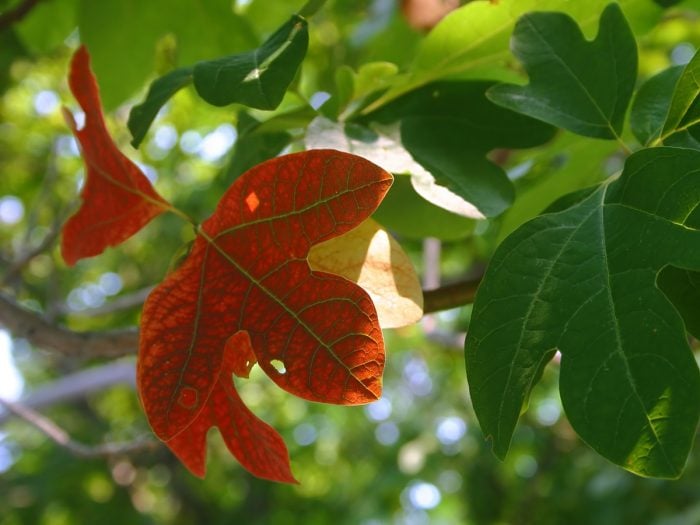Drinking sassafras tea can have several impressive health benefits such as detoxifying the body, breaking fevers, thinning the blood, strengthening the immune system, improving skin health, aiding respiratory health, and reducing inflammation, among others.
What is Sassafras Tea?
Sassafras tea is made from the root and bark of the sassafras tree, a deciduous flowering tree native to North America. The flavor of the tea is reminiscent of root beer, which is why many early recipes for the refreshing beverage include sassafras.
However, this tea also contains safrole, which is deemed to be a carcinogen. It is, therefore, not recommended for use by doctors, particularly in large quantities. Only very small doses of sassafras tea are recommended by herbal practitioners, who still use this plant, despite the proven risks. It has been banned in the United States. Even so, the tree is native to eastern North America and is still used in many areas of the world. [1]
Health Benefits of Sassafras Tea
While there are health risks to consuming an excess of sassafras tea, in moderate amounts it is known to have a positive impact on your liver, circulatory system, immune system, skin, lungs, respiratory tracts, and joints. Much of these benefits come from the volatile compounds in the tea, including alpha-pinene and antioxidant tannins. However, use of this tea should be monitored carefully, and should only be prepared in the right concentrations. If you begin to feel any adverse side effects, discontinue use immediately. [2]
Immune System
Sassafras tea has been traditionally used in small amounts to treat the symptoms of cold and flu. It can help reduce nasal congestion and relieve inflammation in the sinus cavities and throat. [3]
Skin Health
The antibacterial and antiseptic properties of this tea make it effective for skin health. It can aid in the elimination of eczema, psoriasis, and other inflammatory issues when consumed in low to moderate amounts.
Detoxify the Body
As a liver stimulant, sassafras tea can help the body to sweat and detoxify faster, which can further eliminate toxins through the skin. This tea also functions as a great diuretic, meaning that it speeds up urination, which is when excess toxins, fats, salt, and water can be flushed out of the body. For this reason, sassafras tea is also known to boost kidney health when consumed responsibly. [4]

Sassafras tea has a distinct flavor, which is reminiscent of root beer. Photo Credit: Shutterstock
Break Fevers
One of the classic uses of this tea is for stubborn fevers that don’t seem to break. Traditional medicine practitioners have been relying on the anti-inflammatory properties of sassafras tea for generations when they need to break a fever and start the healing process.
Improves Digestion
Small amounts of sassafras tea can help ease digestion by reducing inflammation in the gut and digestive tracts, while also helping regulate your bowel movements, meaning that it can eliminate both diarrhea and constipation. [5]
Improves Circulation
Sassafras tea has an anticoagulant nature to it that helps with thinning the blood, making it less likely for you to suffer from blood clots, heart attacks, and strokes. While this can be dangerous if you are planning on having surgery or are recovering from an injury, keeping your bloodstream clot-free is usually a very good thing. [6]
Inflammatory Problems
People who suffer from gout, joint disorders, and other chronic inflammatory conditions such as arthritis, can benefit from the detoxifying and stimulant nature of sassafras tea. When consumed responsibly, this tea can relieve pain and discomfort very effectively. [7]
How to Make Sassafras Tea?
Sassafras tea can be prepared quite easily at home, and only requires sassafras root, a pot of boiling water, and a strainer, as well as honey or sweetener to enhance the flavor. Take a look at the recipe below.

Sassafras Tea Recipe
Ingredients
- 4 and a 1/4 inches of sassafras root, ( 4 pieces sassafras root 1/4 " to 1/2-inch in diameter)
- 3 cups of water
Instructions
- To make sassafras tea, purchase or gather sassafras root and wash it thoroughly. Cut off any excess plant material, such as the green of a potential sapling or the tips of the roots.
- Bring a pot of water to boil and add the roots. While the roots steep, the color will begin to change to a deep red or brown.
- Once the roots have steeped for 5-10 minutes, strain the mixture to separate the roots and any plant material.
- Add honey or sweetener for flavor.
Notes
Side Effects of Sassafras Tea
There are a number of serious side effects that can result from drinking sassafras tea, including the following: [8]
- Sweating
- High blood pressure
- Vomiting
- Rashes
- Hallucinations
- Chronic diseases
- Liver damage
- Miscarriages
Safrole, one of the primary active ingredients in sassafras, is known to be a carcinogen. In fact, concentrated sassafras oil and sassafras extract can be significantly harmful when consumed in even moderate quantities. While sassafras tea is not nearly as strong, it is still quite powerful, and long-term use is not encouraged.
Pregnant women, breastfeeding women, and children should avoid using sassafras tea, as it can cause miscarriages for pregnant women, and can cause severe side effects in children.
If you are having surgery, drinking sassafras tea can be very dangerous. It slows down the nervous system, which provides some of its health benefits. But in conjunction with anesthesia, the amount of safrole found in this tea can give way to major complications, and even prove fatal.
Only use sassafras tea in extremely limited quantities, and only with permission from a trained medical practitioner, who can ensure that it won’t have negative interactions with any other prescriptions or medications you may be using.
